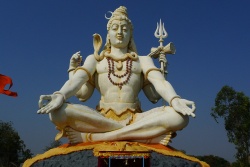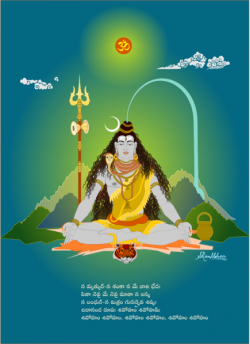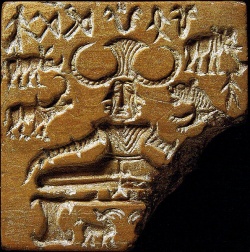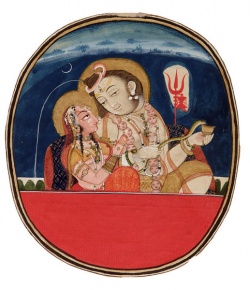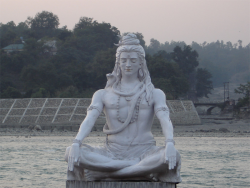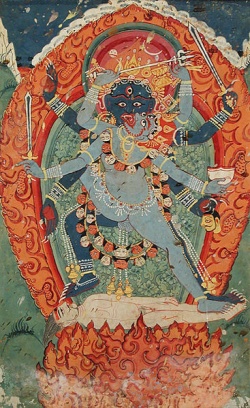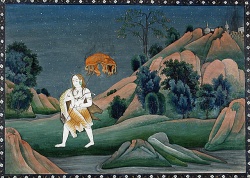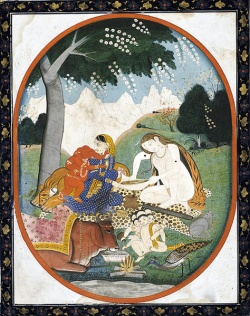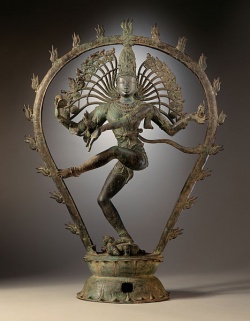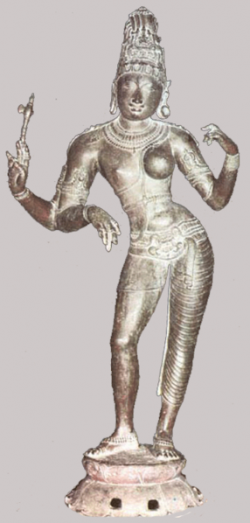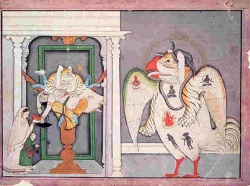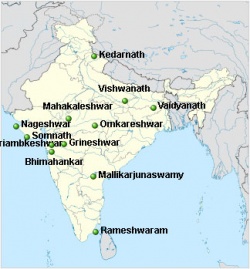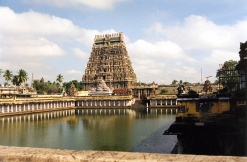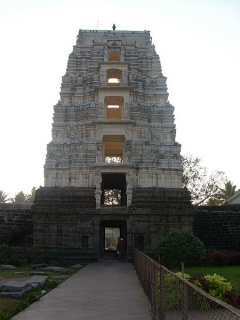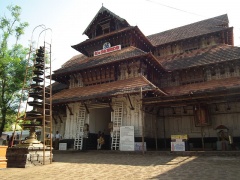Shiva
Shiva (pron.: /ˈʃɪvə/; "ಶಿವ" Kannada, Tamil: சிவன் sivan,శివుడుTelugu meaning "auspicious one") is a Hindu deity. He is considered the Supreme God within Shaivism, one of the three most influential denominations in Hinduism. In other branches of Hinduism such as in the Smarta tradition, he is regarded as one of the five primary forms of God. He is "the Destroyer" or "the Transformer" among the Trimurti, the Hindu Trinity of the primary aspects of the divine
Shiva is usually worshipped in the aniconic form of lingam. He is described as an omniscient yogi, who lives an ascetic life on Mount Kailash, as well as a householder with a wife Parvati and two sons, Ganesha and Kartikeya. Shiva has many benevolent as well as fearsome forms. He is often depicted as immersed in deep meditation, with his wife and children or as the Cosmic Dancer. In fierce aspects, he is often depicted slaying demons.
In many holy texts and puranas like Mahavishnu, Shiva or Mahadeva is also called Paramatman (Supreme soul). Shaivas often see him as Parabrahma (Supreme Brahman), and is regarded as Bhagwaan by devotees. The Shiva Sahasranama (1000 names of Lord Mahadev) declares Shiva as "Paramatman", the supersoul found everywhere. He is commonly connected to the practice of Yoga.
Etymology and other names
The Sanskrit word Shiva (Devanagari: शिव, śiva ) is an adjective meaning "pure and destroyer". As a proper name it means "The Auspicious One", used as a name for Rudra. In simple English transliteration it is written either as Shiva or Siva. The adjective śiva, meaning "auspicious", is used as an attributive epithet not particularly of Rudra, but of several other Vedic deities. The Sanskrit word śaiva means "relating to the god Shiva", and this term is the Sanskrit name both for one of the principal sects of Hinduism and for a member of that sect. It is used as an adjective to characterize certain beliefs and practices, such as Shaivism. He is the oldest worshipped Lord of India.
Adi Sankara, in his interpretation of the name Shiva, the 27th and 600th name of Vishnu sahasranama, the thousand names of Vishnu interprets Shiva to have multiple meanings: "The Pure One", or "the One who is not affected by three Gunas of Prakrti (Sattva, Rajas, and Tamas)" or "the One who purifies everyone by the very utterance of His name." Swami Chinmayananda, in his translation of Vishnu sahasranama, further elaborates on that verse: Shiva means "the One who is eternally pure" or "the One who can never have any contamination of the imperfection of Rajas and Tamas". Shiva is considered to be the Hindu God who has no Aadi or Anta i.e. no beginning/end.
Shiva's role as the primary deity of Shaivism is reflected in his epithets Mahādeva ("Great God"; mahā = Great + deva = God), Maheśvara ("Great Lord"; mahā = Great + īśvara = Lord), and Parameśvara ("Supreme Lord").
There are at least eight different versions of the Shiva Sahasranama, devotional hymns (stotras) listing many names of Shiva. The version appearing in Book 13 (Anuśāsanaparvan) of the Mahabharata is considered the kernel of this tradition. Shiva also has Dasha-Sahasranamas (10,000 names) that are found in the Mahanyasa. The Shri Rudram Chamakam, also known as the Śatarudriya, is a devotional hymn to Shiva hailing him by many names.
Historical development
Origins
The worship of Shiva is a pan-Hindu tradition, practiced widely across all of India, Nepal and Sri Lanka. Some historians believe that the figure of Shiva as we know him today was built up over time, with the ideas of many regional sects being amalgamated into a single figure. Sailen Debnath traces the origin of Shiva to the pre-Aryan period, and believes that he played an important role in the Indus Valley Civilization. How the persona of Shiva converged as a composite deity is not well documented. Axel Michaels explains the composite nature of Shaivism as follows:
- Like Vişņu, Śiva is also a high god, who gives his name to a collection of theistic trends and sects: Śaivism. Like Vaişņavism, the term also implies a unity which cannot be clearly found either in religious practice or in philosophical and esoteric doctrine. Furthermore, practice and doctrine must be kept separate.
An example of assimilation took place in Maharashtra, where a regional deity named Khandoba is a patron deity of farming and herding castes. The foremost center of worship of Khandoba in Maharashtra is in Jejuri Khandoba has been assimilated as a form of Shiva himself, in which case he is worshipped in the form of a lingam. Khandoba's varied associations also include an identification with Surya and Karttikeya.
The Pashupati seal
Seal discovered at Mohenjodaro shows a seated figure surrounded by animals, possibly Shiva,the Pashupati
A seal discovered during the excavation of Mohenjo-daro has drawn attention as a possible representation of a "proto-Shiva" figure. This Pashupati (Lord of animal-like beings) seal shows a seated figure, possibly ithyphallic, surrounded by animals. Sir John Marshall and others have claimed that this figure is a prototype of Shiva and have described the figure as having three faces seated in a "yoga posture" with the knees out and feet joined. However, this claim is not without its share of critics, with some academics like Gavin Flood and John Keay characterizing them as unfounded.
Lord Shiva is believed to be lived in Kailasa, a peak in the Great Himalayas. But some legend said that it is Rudra who lives in Kailasa. Rudra is believed to be an Incarnation of Lord Sadashiva.
Rudra
Shiva as we know him today shares many features with the Vedic god Rudra and both Shiva and Rudra are viewed as the same personality in a number of Hindu traditions. Rudra, the god of the roaring storm, is usually portrayed in accordance with the element he represents as a fierce, destructive deity.
The oldest surviving text of Hinduism is the Rig Veda, which is dated to between 1700 and 1100 BC based on linguistic and philological evidence. A god named Rudra is mentioned in the Rig Veda. The name Rudra is still used as a name for Shiva. In RV 2.33, he is described as the "Father of the Rudras", a group of storm gods. Furthermore, the Rudram, one of the most sacred hymns of Hinduism found both in the Rig and the Yajur Vedas and addressed to Rudra, invokes him as Shiva in several instances, but the term Shiva is used as an epithet for Indra, Mitra and Agni many times.
The identification of Shiva with the older god Rudra is not universally accepted, as Axel Michaels explains:
- Rudra is called "The Archer" (Sanskrit: Śarva), and the arrow is an essential attribute of Rudra. This name appears in the Shiva Sahasranama, and R. K. Sharma notes that it is used as a name of Shiva often in later languages.
The word is derived from the Sanskrit root śarv-, which means "to injure" or "to kill", and Sharma uses that general sense in his interpretive translation of the name Śarva as "One who can kill the forces of darkness". The names Dhanvin ("Bowman") and Bāṇahasta ("Archer", literally "Armed with arrows in his hands") also refer to archery.
Identification with Vedic deities
Shiva's rise to a major position in the pantheon was facilitated by his identification with a host of Vedic deities, including Agni, Indra, Prajāpati, Vāyu, and others.
Agni
Rudra and Agni have a close relationship. The identification between Agni and Rudra in the Vedic literature was an important factor in the process of Rudra's gradual development into the later character as Rudra-Shiva. The identification of Agni with Rudra is explicitly noted in the Nirukta, an important early text on etymology, which says, "Agni is also called Rudra." The interconnections between the two deities are complex, and according to Stella Kramrisch:
- The fire myth of Rudra-Śiva plays on the whole gamut of fire, valuing all its potentialities and phases, from conflagration to illumination. In medieval sculpture, both Agni and the form of Shiva known as Bhairava have flaming hair as a special feature.
Indra
According to a theory, the Puranic Shiva is a continuation of the Vedic Indra. He gives several reasons for his hypothesis. Both Shiva and Indra are known for having a thirst for Soma. Both are associated with mountains, rivers, male fertility, fierceness, fearlessness, warfare, transgression of established mores, the Aum sound, the Supreme Self. In the Rig Veda the term śiva is used to refer to Indra. and 8.93.3. ) Indra, like Shiva, is likened to a bull. In the Rig Veda, Rudra is the father of the Maruts, but he is never associated with their warlike exploits as is Indra.
Position within Hinduism
Shaivism
Shaivism (Sanskrit: शैव पंथ, śaiva paṁtha) (Tamil: சைவ சமயம்) is the oldest of the four major sects of Hinduism, the others being Vaishnavism, Shaktism and Smartism. Followers of Shaivism, called "Shaivas", and also "Saivas" or "Saivites", revere Shiva as the Supreme Being. Shaivas believe that Shiva is All and in all, the creator, preserver, destroyer, revealer and concealer of all that is.
The tantric Shaiva tradition consists of the Kapalikas, Kashmir Shaivism and Shaiva Siddhanta.
The Shiva MahaPurana is one of the purāṇas, a genre of Hindu religious texts, dedicated to Shiva.
Shaivism is widespread throughout India, Nepal, and Sri Lanka, mostly. Areas notable for the practice of Shaivism include parts of Southeast Asia, especially Malaysia, Singapore, and Indonesia.
Panchayatana puja
Panchayatana puja is the system of worship ('puja') in the Smarta sampradaya of Hinduism. It is said to have been introduced by Adi Shankara, the 8th century CE Hindu philosopher. It consists of the worship of five deities: Shiva, Vishnu, Devi, Surya and Ganesha. Depending on the tradition followed by Smarta households, one of these deities is kept in the center and the other four surround it. Worship is offered to all the deities. The five are represented by small murtis, or by five kinds of stones, or by five marks drawn on the floor.
Trimurti
The Trimurti is a concept in Hinduism
- ... in which the cosmic functions of creation, maintenance, and destruction are personified by the forms of Brahmā the creator, Vishnu the maintainer or preserver and Śhiva the destroyer or transformer,"
These three deities have been called "the Hindu triad" or the "Great Trinity", often addressed as "Brahma-Vishnu-Maheshwara."
Iconography and properties
Attributes
Shiva is depicted three-eyed, the Ganges flowing through his matted hair (which are yellowish-white or like molten gold), wearing ornaments of serpents and a skull bracelet, and covered in ashes, and Trisula and Damaru are seen in the background.
- Shiva's form: Shiva has a Trident in the right lower arm, with a crescent moon on his head. He is said to be fair like camphor or like an ice clad mountain. He has fire and Damaru and Mala or a kind of weapon. He wears five serpents as ornaments. He wears a garland of skulls. He is pressing with his feet the demon Muyalaka, a dwarf holding a cobra. He faces south. Panchakshara itself is his body. (The trident, like almost all other forms in Hinduism, can be understood as the symbolism of the unity of three worlds that a human faces - his inside world, his immediate world, and the broader overall world. At the base of the trident, all three forks unite.)
- Third eye: (Trilochana) Shiva is often depicted with a third eye, with which he burned Desire (Kāma) to ashes, called "Tryambakam" (Sanskrit: त्र्यम्बकम्), which occurs in many scriptural sources. In classical Sanskrit, the word ambaka denotes "an eye", and in the Mahabharata, Shiva is depicted as three-eyed, so this name is sometimes translated as "having three eyes". However, in Vedic Sanskrit, the word ambā or ambikā means "mother", and this early meaning of the word is the basis for the translation "three mothers". These three mother-goddesses who are collectively called the Ambikās. Other related translations have been based on the idea that the name actually refers to the oblations given to Rudra, which according to some traditions were shared with the goddess Ambikā.
- Crescent moon: (The epithets "Chandrasekhara/Chandramouli")- Shiva bears on his head the crescent moon. The epithet Candraśekhara (Sanskrit: चन्द्रशेखर "Having the moon as his crest" - candra = "moon"; śekhara = "crest, crown") refers to this feature. The placement of the moon on his head as a standard iconographic feature dates to the period when Rudra rose to prominence and became the major deity Rudra-Shiva. The origin of this linkage may be due to the identification of the moon with Soma, and there is a hymn in the Rig Veda where Soma and Rudra are jointly implored, and in later literature, Soma and Rudra came to be identified with one another, as were Soma and the moon. The crescent moon is shown on the side of the Lord's head as an ornament. The waxing and waning phenomenon of the moon symbolizes the time cycle through which creation evolves from the beginning to the end. Since the Lord is the Eternal Reality, He is beyond time. Thus, the crescent moon is only one of His ornaments. The wearing of the crescent moon in his head indicates that He has controlled the mind perfectly.
- Ashes: (The epithet "Bhasmaanga Raaga") - Shiva smears his body with ashes (bhasma). Ashes represent the final reality that a human being will face - the end of all material existence. Some forms of Shiva, such as Bhairava, are associated with a very old Indian tradition of cremation-ground asceticism that was practiced by some groups who were outside the fold of brahmanic orthodoxy. These practices associated with cremation grounds are also mentioned in the Pali canon of Theravada Buddhism. One epithet for Shiva is "inhabitant of the cremation ground" (Sanskrit: śmaśānavāsin, also spelled Shmashanavasin), referring to this connection. It is interesting to see the peaceful acceptance of cremation ground temples of Batuk Bhairava, a form of Lord Shiva, by the general populace. At Ujjain, near the Kaal Bhairava temple lies such a cremation ground temple of Batuk Bhairava, with its legendary disciple Baba Dabral known throughout Central India (as he is blessed, people say, with the ability to literally read out incidents of the future in one's life just by holding one's palm).
- Matted hair: (The epithet "Jataajoota Dhari/Kapardin") - Shiva's distinctive hair style is noted in the epithets Jaṭin, "the one with matted hair", and Kapardin, "endowed with matted hair" or "wearing his hair wound in a braid in a shell-like (kaparda) fashion". A kaparda is a cowrie shell, or a braid of hair in the form of a shell, or, more generally, hair that is shaggy or curly. His hair is said to be like molten gold in color or being yellowish-white.
- Blue throat: The epithet Nīlakaṇtha (Sanskrit नीलकण्ठ; nīla = "blue", kaṇtha = "throat") since Shiva drank the Holahola poison churned up from the Samudra Manthan to eliminate its destructive capacity. Shocked by his act, Goddess Parvati strangled his neck and hence managed to stop it in his neck itself and prevent it from spreading all over the universe supposed to be in Shiva's stomach. However the poison was so potent that it changed the color of his neck to blue. (See Maha Shivaratri.)
- Sacred Ganges: (The epithet "Gangadhara") Bearer of Ganga. Ganges river flows from the matted hair of Shiva. y.
- Tiger skin: (The epithet "Krittivasan").He is often shown seated upon a tiger skin, an honour reserved for the most accomplished of Hindu ascetics, the Brahmarishis. Tiger represents lust. His sitting on the tiger’s skin indicates that He has conquered lust.
- Serpents: (The epithet "Nagendra Haara"). Shiva is often shown garlanded with a snake. His wearing of serpents on the neck denotes wisdom and eternity.
- Deer:His holding deer on one hand indicates that He has removed the Chanchalata of the mind (i.e., attained maturity and firmness in thought process). Deer jumps from one place to another swiftly, similar to the mind moving from one thought to another.
- Trident: (Sanskrit: Trishula): Shiva's particular weapon is the trident. His Trisul that is held in His right hand represents the three Gunas—Sattva, Rajas and Tamas. That is the emblem of sovereignty. He rules the world through these three Gunas. The Damaru in His left hand represents the Sabda Brahman. It represents OM from which all languages are formed. It is He who formed the Sanskrit language out of the Damaru sound.
- Drum: A small drum shaped like an hourglass is known as a damaru (Sanskrit: ḍamaru). This is one of the attributes of Shiva in his famous dancing representation known as Nataraja. A specific hand gesture (mudra) called ḍamaru-hasta (Sanskrit for "ḍamaru-hand") is used to hold the drum. This drum is particularly used as an emblem by members of the Kāpālika sect.
- Axe: (Sanskrit: Parashu):The parashu is the weapon of Lord Shiva who gave it to Parashurama, sixth Avatar of Vishnu, whose name means "Rama with the axe" and also taught him its mastery.
- Nandī: (The epithet "Nandi Vaahana").Nandī, also known as Nandin, is the name of the bull that serves as Shiva's mount (Sanskrit: vāhana). Shiva's association with cattle is reflected in his name Paśupati, or Pashupati (Sanskrit: पशुपति), translated by Sharma as "lord of cattle" and by Kramrisch as "lord of animals", who notes that it is particularly used as an epithet of Rudra. Rishabha or the bull represents Dharma Devata. Lord Siva rides on the bull. Bull is his vehicle. This denotes that Lord Siva is the protector of Dharma, is an embodiment of Dharma or righteousness.
- Gaṇa: The Gaṇas (Devanagari: गण) are attendants of Shiva and live in Kailash. They are often referred to as the bhutaganas, or ghostly hosts, on account of their nature. Generally benign, except when their lord is transgressed against, they are often invoked to intercede with the lord on behalf of the devotee. Ganesha was chosen as their leader by Shiva, hence Ganesha's title gaṇa-īśa or gaṇa-pati, "lord of the gaṇas".
- Mount Kailāsa: Mount Kailash in the Himalayas is his traditional abode. In Hindu mythology, Mount Kailāsa is conceived as resembling a Linga, representing the center of the universe.
- Varanasi: Varanasi (Benares) is considered to be the city specially loved by Shiva, and is one of the holiest places of pilgrimage in India. It is referred to, in religious contexts, as Kashi.
Lingam
Apart from anthropomorphic images of Shiva, the worship of Shiva in the form of a lingam, or linga, is also important. These are depicted in various forms. One common form is the shape of a vertical rounded column. Shiva means auspiciousness, and linga means a sign or a symbol. Hence, the Shivalinga is regarded as a "symbol of the great God of the universe who is all-auspiciousness". Shiva also means "one in whom the whole creation sleeps after dissolution". Linga also means the same thing—a place where created objects get dissolved during the disintegration of the created universe. Since, according to Hinduism, it is the same god that creates, sustains and withdraws the universe, the Shivalinga represents symbolically God Himself. Some scholars, such as Monier-Williams and Wendy Doniger, also view linga as a phallic symbol, although this interpretation is disputed by others, including Christopher Isherwood, Vivekananda, Swami Sivananda, and S.N. Balagangadhara.
The worship of the Shiva-Linga originated from the famous hymn in the Atharva-Veda Samhitâ sung in praise of the Yupa-Stambha, the sacrificial post. In that hymn, a description is found of the beginningless and endless Stambha or Skambha, and it is shown that the said Skambha is put in place of the eternal Brahman. Just as the Yajna (sacrificial) fire, its smoke, ashes, and flames, the Soma plant, and the ox that used to carry on its back the wood for the Vedic sacrifice gave place to the conceptions of the brightness of Shiva's body, his tawny matted hair, his blue throat, and the riding on the bull of the Shiva, the Yupa-Skambha gave place in time to the Shiva-Linga. In the text Linga Purana, the same hymn is expanded in the shape of stories, meant to establish the glory of the great Stambha and the superiority of Shiva as Mahadeva.
Shakti
Shiva forms a Tantric couple with Shakti, the embodiment of energy and dynamism, and the motivating force behind all action and existence in the material universe. Shiva is her transcendent masculine aspect, providing the divine ground of all being.
Shakti manifests in several female deities. Sati and Parvati are the main consorts of Shiva, but she is also manifested as Uma, Durga (Parvata), Kali and Chandika.
Kali is the manifestation of Shakti in her dreadful aspect. The name Kali comes from kāla, which means black, time, death, lord of death, Shiva. Since Shiva is called Kāla, the eternal time, Kālī, his consort, also means "Time" or "Death" (as in "time has come"). Various Shakta Hindu cosmologies, as well as Shākta Tantric beliefs, worship her as the ultimate reality or Brahman. She is also revered as Bhavatārini (literally "redeemer of the universe"). Kālī is represented as the consort of Lord Shiva, on whose body she is often seen standing or dancing. Shiva is the masculine force, the power of peace, while Shakti translates to power, and is considered as the feminine force. In the Vaishnava tradition, these realities are portrayed as Vishnu and Laxmi, or Radha and Krishna. These are differences in formulation rather than a fundamental difference in the principles. Both Shiva and Shakti have various forms. Shiva has forms like Yogi Raj (the common image of Himself meditating in the Himalayas), Rudra (a wrathful form) and Nataraj (performing the dance of destruction).
The five mantras
Five is a sacred number for Shiva. One of his most important mantras has five syllables (namaḥ śivāya).
Shiva's body is said to consist of five mantras, called the pañcabrahmans As forms of God, each of these have their own names and distinct iconography:
These are represented as the five faces of Shiva and are associated in various texts with the five elements, the five senses, the five organs of perception, and the five organs of action. Doctrinal differences and, possibly, errors in transmission, have resulted in some differences between texts in details of how these five forms are linked with various attributes. The overall meaning of these associations is summarized by Stella Kramrisch:
- Through these transcendent categories, Śiva, the ultimate reality, becomes the efficient and material cause of all that exists.
According to the Pañcabrahma Upanishad:
- One should know all things of the phenomenal world as of a fivefold character, for the reason that the eternal verity of Śiva is of the character of the fivefold Brahman. (Pañcabrahma Upanishad
Forms
According to Gavin Flood, "Shiva is a god of ambiguity and paradox," whose attributes include opposing themes. The ambivalent nature of this deity is apparent in some of his names and the stories told about him.
Destroyer versus benefactor
In the Yajurveda, two contrary sets of attributes for both malignant or terrific (Sanskrit: rudra) and benign or auspicious (Sanskrit: śiva) forms can be found, leading Chakravarti to conclude that "all the basic elements which created the complex Rudra-Śiva sect of later ages are to be found here". In the Mahabharata, Shiva is depicted as "the standard of invincibility, might, and terror", as well as a figure of honor, delight, and brilliance. The duality of Shiva's fearful and auspicious attributes appears in contrasted names.
The name Rudra (Sanskrit: रुद्र) reflects his fearsome aspects. According to traditional etymologies, the Sanskrit name Rudra is derived from the root rud-, which means "to cry, howl". Stella Kramrisch notes a different etymology connected with the adjectival form raudra, which means "wild, of rudra nature", and translates the name Rudra as "the wild one" or "the fierce god". R. K. Sharma follows this alternate etymology and translates the name as "terrible". Hara (Sanskrit: हर) is an important name that occurs three times in the Anushasanaparvan version of the Shiva sahasranama, where it is translated in different ways each time it occurs, following a commentorial tradition of not repeating an interpretation. Sharma translates the three as "one who captivates", "one who consolidates", and "one who destroys". Kramrisch translates it as "the ravisher". Another of Shiva's fearsome forms is as Kāla (Sanskrit: काल), "time", and as Mahākāla (Sanskrit: महाकाल), "great time", which ultimately destroys all things. Bhairava (Sanskrit: भैरव), "terrible" or "frightful", is a fierce form associated with annihilation.
In contrast, the name Śaṇkara (Sanskrit: शङ्कर), "beneficent" or "conferring happiness" reflects his benign form. This name was adopted by the great Vedanta philosopher Śaṇkara (c. 788 - 820 CE), who is also known as Shankaracharya. The name Śambhu (Sanskrit: शम्भु), "causing happiness", also reflects this benign aspect.
Ascetic to householder
An illustration of the family of Shiva, consisting of Shiva, Parvati, Ganesha and Skanda (Kartikeya)
He is depicted as both an ascetic yogi and as a householder, roles which have been traditionally mutually exclusive in Hindu society. When depicted as a yogi, he may be shown sitting and meditating. His epithet Mahāyogi ("the great Yogi: Mahā = "great", Yogi = "one who practices Yoga") refers to his association with yoga. While Vedic religion was conceived mainly in terms of sacrifice, it was during the Epic period that the concepts of tapas, yoga, and asceticism became more important, and the depiction of Shiva as an ascetic sitting in philosophical isolation reflects these later concepts. Shiva is also depicted as a corpse below Goddess Kali, it represents that Shiva is a corpse without Shakti. He remains inert. While Shiva is the static form. Mahakali or Shakti is the dynamic aspect without whom Shiva is powerless.
As a family man and householder, he has a wife, Parvati, and two sons, Ganesha and Kartikeya. His epithet Umāpati ("The husband of Umā") refers to this idea, and Sharma notes that two other variants of this name that mean the same thing, Umākānta and Umādhava, also appear in the sahasranama. Umā in epic literature is known by many names, including the benign Pārvatī. She is identified with Devi, the Divine Mother; Shakti (divine energy) as well as goddesses like Tripura Sundari, Durga, Kamakshi and Meenakshi. The consorts of Shiva are the source of his creative energy. They represent the dynamic extension of Shiva onto this universe. His son Ganesha is worshipped throughout India and Nepal as the Remover of Obstacles, Lord of Beginnings and Lord of Obstacles. Kartikeya is worshipped in Southern India (especially in Tamil Nadu, Kerala and Karnataka) by the names Subrahmanya, Subrahmanyan, Shanmughan, Swaminathan and Murugan, and in Northern India by the names Skanda, Kumara, or Karttikeya.
Nataraja
Chola dynasty statue depicting Shiva dancing as Nataraja (Los Angeles County Museum of Art)
The depiction of Shiva as Nataraja (Tamil: நடராஜா,Kannada: ನಟರಾಜ, Telugu: నటరాజు, Sanskrit: naṭarāja, "Lord of Dance") is popular. The names Nartaka ("dancer") and Nityanarta ("eternal dancer") appear in the Shiva Sahasranama. His association with dance and also with music is prominent in the Puranic period. In addition to the specific iconographic form known as Nataraja, various other types of dancing forms (Sanskrit: nṛtyamūrti) are found in all parts of India, with many well-defined varieties in Tamil Nadu in particular. The two most common forms of the dance are the Tandava, which later came to denote the powerful and masculine dance as Kala-Mahakala associated with the destruction of the world. When it requires the world or universe to be destroyed, Lord Śiva does it by the tāṇḍavanṛtya. and Lasya, which is graceful and delicate and expresses emotions on a gentle level and is considered the feminine dance attributed to the goddess Parvati. Lasya is regarded as the female counterpart of Tandava. The Tandava-Lasya dances are associated with the destruction-creation of the world.
Dakshinamurthy
Dakshinamurthy, or Dakṣiṇāmūrti (Tamil:தட்சிணாமூர்த்தி, Telugu: దక్షిణామూర్తి, Sanskrit: दक्षिणामूर्ति), literally describes a form (mūrti) of Shiva facing south (dakṣiṇa). This form represents Shiva in his aspect as a teacher of yoga, music, and wisdom and giving exposition on the shastras. This iconographic form for depicting Shiva in Indian art is mostly from Tamil Nadu. Elements of this motif can include Shiva seated upon a deer-throne and surrounded by sages who are receiving his instruction.
Ardhanarishvara
An iconographic representation of Shiva called (Ardhanārīśvara) shows him with one half of the body as male and the other half as female. According to Ellen Goldberg, the traditional Sanskrit name for this form (Ardhanārīśvara) is best translated as "the lord who is half woman", not as "half-man, half-woman". According to legend, Lord Shiva is pleased by the difficult austerites performed by the Goddess Parvati, grants her the left half of his body. This form of Shiva is quite similar to the Yin-Yang philosophy of Eastern Asia, though Ardhanārīśvara appears to be more ancient.
Tripurantaka
Shiva is often depicted as an archer in the act of destroying the triple fortresses, Tripura, of the Asuras. Shiva's name Tripurantaka (Sanskrit: त्रिपुरान्तक, Tripurāntaka), "ender of Tripura", refers to this important story. In this aspect, Shiva is depicted with four arms wielding a bow and arrow, but different from the Pinakapani murti. He holds an axe and a deer on the upper pair of his arms. In the lower pair of the arms, he holds a bow and an arrow respectively. After destroying Tripura, Tripurantaka Shiva smeared his forehead with three strokes of Ashes. This has become a prominent symbol of Shiva and is practiced even today by Shaivites.
Maheshvara
In the form of Maheshvara (Japanese: 大自在天 Daijizai-ten), Shiva plays a role in Buddhist Tantra.
A popular story tells how Vajrapani kills Mahesvara, a manifestation of Shiva depicted as an evil being. The story occurs in several scriptures, most notably the Sarvatathagatatattvasamgraha and the Vajrapany-abhiseka-mahatantra. The story begins with the transformation of the Bodhisattva Samantabhadra into Vajrapani by Vairocana, the cosmic Buddha, receiving a vajra and the name "Vajrapani". Vairocana then requests Vajrapani to generate his adamantine family, to establish a mandala. Vajrapani refuses, because Mahesvara (Shiva) "is deluding beings with his deceitfull religious doctrines and engaging in all kinds of violent criminal conduct". Mahesvara and his entourage are dragged to Mount Sumeru, and all but Mahesvara submit. Vajrapani and Mahesvara engage in a magical combat, which is won by Vajrapani. Mahesvara's retinue become part of Vairocana's mandala, except for Mahesvara, who is killed, and his life transferred to another realm where he becomes a buddha named Bhasmesvara-nirghosa, the "Soundless Lord of Ashes".
According to Kalupahana, the story "echoes" the story of the conversion of Ambattha. It is to be understood in the context of the competition between Buddhist institutions and Shaivism.
Avatars
Shiva, like some other Hindu deities, is said to have several incarnations, known as Avatars. Although Puranic scriptures contain occasional references to "ansh" avatars of Shiva, the idea is not universally accepted in Saivism. The Linga Purana speaks of twenty-eight forms of Shiva which are sometimes seen as avatars. In the Shiva Purana there is a distinctly Saivite version of a traditional avatar myth:
- Virabhadra who was born when Shiva grabbed a lock of his matted hair and dashed it to the ground. Virabhadra then destroyed Daksha's yajna (fire sacrifice) and severed his head as per Shiva's instructions.
- Bhairava, Bhairava (Sanskrit: भैरव, "Terrible" or "Frightful", ), sometimes known as Bhairo or Bhairon or Bhairadya or Bheruji (In Rajasthan), is the fierce manifestation of Shiva associated with annihilation. He is one of the most important deities of Rajasthan and Nepal, sacred to Hindus and Buddhists alike. When depicted as Kala Bhairava, Bhairava is shown carrying the decapitated head of Brahma.
- Sharabha, Shaiva scriptures narrate that god Shiva assumed the Avatar (incarnation) of Sharabha to tame Narasimha - the fierce man-lion avatar of Vishnu worshipped by Vaishnava sect - into a normal pleasant form representing harmony. This form is popularly known as Sarabeshwara ("Lord Sarabha") or Sharabeshwaramurti. In Buddhism, Sharabha appears in Jataka Tales as a previous birth of the Buddha.
- Durvasa (दुर्वास in Devanagari or durvāsa in IAST, pronounced [d̪urʋɑːsɐ] in classical Sanskrit), or Durvasas, was an ancient sage, the son of Atri and Anasuya. He is supposed to be an incarnation of Shiva. He is known for his short temper. Hence, wherever he went, he was received with great reverence from humans and Devas alike.
- Khandoba, a form of Shiva, mainly in the Deccan plateau of India, especially in the states of Maharashtra and Karnataka. He is the most popular family deity in Maharashtra.
- Adi Shankara, the 8th-century philosopher of non-dualist Vedanta "Advaita Vedanta", was named "Shankara" after Lord Shiva and is considered by some to have been an incarnation of Shiva.
- In the Hanuman Chalisa, Hanuman is identified as the eleventh avatar of Shiva and this belief is universal. Mahabhagvata Purana, Skanda Purana. However, Hanuman knows as “Rudraavtaar” “Rudra” is name of “Shiva” people believe that Hanuman is the incarnation of Shiva. The vanar(ancestors of humans)-god Hanuman who helped Rama – the Vishnu avatar is considered by some to be the eleventh avatar of Rudra (Shiva).
- In Dasam Granth, Guru Gobind Singh have mentioned two avtars of Rudra: Dattatreya Avtar and Parasnath Avtar.
- Harihara is the name of a combined deity form of both Vishnu (Hari) and Shiva (Hara) from the Hindu tradition. Also known as Shankaranarayana ("Shankara" is Shiva, and "Narayana" is Vishnu), Harihara is thus worshipped by both Vaishnavites and Shaivities as a form of the Supreme God, as well as being a figure of worship for other Hindu traditions in general. Harihara is also sometimes used as a philosophical term to denote the unity of Vishnu and Shiva as different aspects of the same Supreme God. The exact nature of both Vishnu and Shiva (from their associated stories in Vedic and Puranic scriptures), and their position of difference or unity (or both), is a subject of some debate amongst the different philosophical schools.
Relationship to Vishnu
During the Vedic period, both Vishnu and Shiva (as identified with Rudra) played relatively minor roles, but by the time of the Brahmanas (c. 1000 - 700 BC), both were gaining ascendance. By the Puranic period, both deities had major sects that competed with one another for devotees. Many stories developed showing different types of relationships between these two important deities.
Sectarian groups each presented their own preferred deity as supreme. Vishnu in his myths "becomes" Shiva. The Vishnu Purana (4th century CE) shows Vishnu awakening and becoming both Brahmā to create the world and Shiva to destroy it. Shiva also is viewed as a manifestation of Vishnu in the Bhagavata Purana. In Shaivite myths, on the other hand, Shiva comes to the fore and acts independently and alone to create, preserve, destroy, hide, and to bless (five works). In one Shaivite myth of the origin of the lingam, both Vishnu and Brahmā are revealed as emanations from Shiva's manifestation as a towering pillar of flame. The Śatarudrīya, a Shaivite hymn, says that Shiva is "of the form of Vishnu". Differences in viewpoints between the two sects are apparent in the story of Śarabha (also spelled "Sharabha"), the name of Shiva's incarnation in the composite form of man, bird, and beast. Shiva assumed that unusual form of Sarabheshwara to chastise Vishnu, who in his hybrid form as Narasimha, the man-lion, killed Hiranyakashipu. However, Vaishnava followers including Dvaita scholars, such as Vijayindra Tirtha (1539–95) dispute this view of Narasimha based on their reading of Sattvika Puranas and Śruti texts.
Syncretic forces produced stories in which the two deities were shown in cooperative relationships and combined forms. Harihara is the name of a combined deity form of both Vishnu (Hari) and Shiva (Hara). This dual form, which is also called Harirudra, is mentioned in the Mahabharata. An example of a collaboration story is one given to explain Shiva's epithet Mahābaleśvara, "lord of great strength" (Maha = "great", Bala = "strength", Īśvara = "lord"). This name refers to a story in which Rāvaṇa was given a linga as a boon by Shiva on the condition that he carry it always. During his travels, he stopped near the present Gokarna, India in Karnataka to purify himself and asked Ganesha, a son of Parvathi in the guise of a young Brahmin, to hold the linga for him, but after some time, Ganesha put it down on the ground and vanished. When Ravana returned, he could not move the linga, and it is said to remain there ever since.
As one story goes, Shiva is enticed by the beauty and charm of Mohini, Vishnu's female avatar, and procreates with her. As a result of this union, Shasta - identified with regional deities Ayyappa and Ayyanar - is born.
Festivals
Maha Shivaratri
Maha Shivratri is a festival celebrated every year on the 13th night or the 14th day of the new moon in the Krishna Paksha of the month of Maagha or Phalguna in the Hindu calendar. This festival is of utmost importance to the devotees of Lord Shiva.
Mahashivaratri marks the night when Lord Shiva performed the 'Tandava' and it is also believed that Lord Shiva was married to Parvati.
On this day the devotees observe fast and offer fruits, flowers and Bael leaves to Shiva Linga.
Karthikai Deepam
Karthikai Deepam (Tamil: கார்த்திகை தீபம்) or Karthikai vilakkidu (Tamil: கார்த்திகைத் விளக்கீடு) also known as Karthika Deepam (కార్తీక దీపం) in Telugu ] is a Hindu specially Hindu Tamils and Hindu Telugu festival. The festival is observed in every home and every temple, and falls in the month of Kārttikai (mid-November to mid-December) as per Tamil calendar. This occurs on the day when the moon is in conjunction with the constellation Karthigai (Pleiades) and purnimai. This constellation appears as a group of six stars in the firmament in the shape of a pendant from the ear.
Many legends and lyrical poetry have grown round this star. The six stars are considered in Indian mythology as the six celestial nymphs who reared the six babies in the saravana tank which later were joined together to form the six faced Muruga. He is therefore called Karthikeya, the one brought up by the Karthigai nymphs. Houses and streets are lit up with rows of oil lamps (Deepam) in the evening of the festival day.
Teej
Teej (तीज) is a fasting festival for Hindu women. It is mainly celebrated in Rajasthan, Bihar and Haryana in (India) and in Nepal and is considered as the most standard form of teej. It is also celebrated in some states of India but has almost vanished nowadays.
It takes place on the third day of Shukla Paksha (bright moon fortnight) of the Shraavana or Saawan month of Hindu calendar that normally falls from late July to early September. Dedicated to the Goddess Parvati, commemorating her union with Lord Shiva, the festival is celebrated for marital bliss, well-being of spouse and children and purification of own body and soul. The festival is a three-day-long celebration that combines sumptuous feasts as well as rigid fasting.
Falling on the Hindu month of Bhadrapada or Bhado (August/September), it also celebrates the arrival of monsoon after a season of oppressive heat. "Teej" is a small red insect that comes out of the soil during rains.
Temples
There are many Shiva temples in the Indian subcontinent, the Jyotirlinga temples being the most prominent.
Jyotirlinga temples
The holiest Shiva temple is Pashupatinath Temple, located in Nepal. Other holiest Shiva temples are the 12 Jyotirlinga temples.
| Jyotirlinga | Location | |
|---|---|---|
| Somnath |  |
Prabhas Patan, near Veraval, Gujarat |
| Mahakaleshwar | 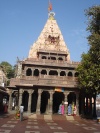 |
Ujjain, Madhya Pradesh |
| Omkareshwar |  |
near Indore, Madhya Pradesh |
| Kedarnath |  |
Kedarnath, Uttarakhand |
| Bhimashankar |  |
Disputed:
|
| Kashi Vishwanath Temple|Kashi Vishwanath | Varanasi, Uttar Pradesh | |
| Trimbakeshwar Shiva Temple|Trimbakeshwar |  |
Trimbak, near Nasik, Maharashtra |
| Ramanathaswamy Temple, Rameswaram|Ramanathaswamy | 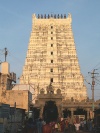 |
Rameswaram, Tamil Nadu|Rameswaram, Tamil Nadu |
| Grishneshwar |  |
near Ellora, Maharashtra |
| Vaidyanath | Disputed:
| |
| Nageshwar |  |
Disputed:
|
| Mallikarjuna Swamy |  |
Srisailam, Andhra Pradesh |
Manifestations
In South India, five temples of Shiva are held to be particularly important, as being manifestations of him in the five elemental substances:
| Deity | Manifestation | Temple | Location | State |
|---|---|---|---|---|
| Jambhukeswar | Water | Jambukeswarar Temple, Thiruvanaikaval | Trichy | Tamil Nadu |
| Arunachaleswar | Fire | Annamalaiyar Temple | Thiruvannamalai | Tamil Nadu |
| Kalahastheeswara | Air | Srikalahasti temple | Srikalahasti | Andhra Pradesh |
| Vanmikanathar | Earth | Thyagaraja Temple | Thiruvarur | Tamil Nadu |
| Ekambareswar | Earth | Ekambareswarar Temple | Kanchipuram | Tamil Nadu |
| Nataraja | Sky | Natarajar Temple | Chidambaram | Tamil Nadu |
Panchaaraama temples
The Pancharama Kshetras (or the Pancharamas) are five ancient Hindu temples of Lord Shiva situated in Andhra Pradesh. The Sivalingas at these temples are made from a single Sivalinga. As per the legend, this Sivalinga was owned by the demon king Tarakasura. No one could win over him due to the power of this Sivalinga. Finally, Lord Kumaraswamy, the son of Lord Shiva broke the Sivalinga into five pieces and killed Tarakasura. The five pieces of Sivalinga fell at five different places on earth namely,
| Arama Name | Siva's Name | Consort Name | Location | State |
|---|---|---|---|---|
| Amararama | Amaralingeswara Swamy | Bala Chamundika Ammavaru | Amaravathi | Andhra Pradesh |
| Draksharama | Bhimesvara Swamy | Manikyamba Ammavaru | Draksharama | Andhra Pradesh |
| Somarama | Someswara Swamy | Sri Rajarajeswari Ammavaru | Bhimavaram | Andhra Pradesh |
| Ksheerarama | Ksheera Ramalingeswara Swamy | Parvati Ammavaru | Palakol | Andhra Pradesh |
| Bhimarama | Kumara Bhimeswara Swamy | Bala Tripurasundari Ammavaru | Samalkota | Andhra Pradesh |
Sabha temples
The five sabha temples where Shiva is believed to perform five different style of dances are:
| Sabha | Temple | Location | State |
|---|---|---|---|
| Pon (Gold) Sabha | Natarajar Temple | Chidambaram | Tamil Nadu |
| Velli (Silver) Sabha | Meenakshi Sundareswarar Temple | Madurai | Tamil Nadu |
| Tamira (Copper) Sabha | Nellaiappar Temple | Tirunelveli | Tamil Nadu |
| Rathna (Gem) Sabha | Thiruvalankadu Vadaaranyeswarar Temple | Thiruvalangadu near Arakkonam |
Tamil Nadu |
| Chitira (Picture) Sabha | Kutraleeswar Temple | Coutrallam | Tamil Nadu |
Other famous temples in India
- Airavatesvara Temple, Darasuram, Thanjavur District
- Rockfort Ucchi Pillayar Temple, Tiruchirappalli
- Brihadeeswarar Temple, Thanjavur
- Sangameswarar Temple, Bhavani, Erode district
- Arthanareeswara Temple, Tiruchengode, Namakkal district
- Sri Adhikumbeswarar Temple, Kumbakonam, Tanjore district
- Daksheswara Mahadev Temple, Kankhal
- Rudreshwar Mahadev Temple
- Baleshwar Temple, Champawat
- Baijnath, Uttarakhand
- Jageshwar, Almora
- Gopinath Mandir, Chamoli Gopeshwar
- Neelkanth Mahadev Temple, near Rishikesh
- Panch Kedar
- Somnath, the first of the 12 Jyotirlinga. Junagadh district
- Nageshvara Jyotirlinga, Dwarka, Jamnagar district
- Bhavnath, Junagadh
- Koteshwar, Kutch, Lakhpat, Kutch District
- Chakhanda Mahadev, Bhadreswar, Kutch
- Rudra Mahalaya, Sidhpur
- Dholeshwar, Gandhinagar outskirts
- Galteshwar, Dakor, Kheda district
- Shoolpaneshwar, Narmada district
- Angareshwar, Narmada Banks, nearby Sinor, Vadodara district
- Nareshwar, Narmada Banks, Vadodara district
- Shuklatirth, Narmada Banks, Bharuch district
- Shukleshwar Mahadev, Vyara
- Kedareshwar, Bardoli, Surat district
- Trinetreshwar, Tarnetar, Surendranagar district
- Bhimnath Mahadev, Dhandhuka, Ahmedabad district
- Ghela Somnath, Rajkot district
- Gautameshwar, Sihor, Bhavnagar district
- Nishkalank Mahadev, Koliyak, Bhavnagar district
- Gopnath, Talaja, Bhavnagar district
- Gangeshwar Temple, Diu
- The Leaning Temple of Huma, Sambalpur
- Lingaraj Temple, Bhubaneswar
- Kapilash Temple, Dhenkanal District
- Mukteswar Temple, Bhubaneswar
- Parsurameswar Temple, Bhubaneswar
- Akhandalamani Temple, Bhadrak
- Chandaneswar, Balasore
- Dhabaleswar, Cuttack
- Gupteswar Cave temple, near Jeypore
- Madhya Pradesh
- Vemulawada, Karimnagar district
- Kapila Theertham, Chittoor district
- Srikalahasti Temple, Srikalahasti
- Kaleshwaram, Karimnagar district
- Keesaragutta, Ranga Reddy district
- Ramappa temple, Warangal district
- Ettumanoor Mahadevar Temple, Ettumanoor
- Vaikom Temple, Vaikom
- Kaduthuruthy, Kaduthuruthy
- Rajarajeshwara Temple, Taliparamba
- Vadakkunnathan Temple, Thrissur
- Poonkunnam Siva Temple, Poonkunnam
- Murudeshwara, Uttara Kannada district—World's second tallest Shiva statue
- Dharmasthala Manjunatha Temple, Dakshina Kannada
- Srikanteshwara Temple, Nanjangud, Mysore District
- Kotilingeshwara, Kammasandra, Kolar District
- Gokarna, Kumta, Uttara Kannada District
- Tarakeswar
Shiva temples are very prominent in Mauritius too. There is a standing shiva statue in Mauritius too.
Famous temples in other countries
- Pashupatinath Temple located on the banks of Bagmati River in the eastern part of Kathmandu, Nepal
- Koneswaram temple located on Swami Rock/Kona-ma-malai, in Trincomalee in the eastern part of Sri Lanka
- Lake Mansarovar and Mount Kailash in Tibet, a pilgrimage site believed to be the abode of Lord Shiva
- Gosaikunda Lake located in Rasuwa District, Nepal
- Doleshwar Mahadev temple located in Bhaktapur, Nepal. It is believed to house the head of Lord Shiva, whose body lies in the Kedarnath Temple of India.
- Halesi Mahadev, a sacred pilgrimage inside a massive cave, located in Khotang District of Nepal
- Kailashnath Mahadev Statue Situated on a mountain near Kathmandu, Nepal.World's tallest lord Shiva statue.
- Prambanan temple dedicated to trimurthi which was exactly located 18 km(11 mi) from the city of Yogyakarta on the boundary between Central Java and Yogyakarta provinces located in the country of Indonesia
In popular media
- Devon Ke Dev...Mahadev a historical and myhtological play telecasted on Life OK from Sunday to Saturday which portrays the life of Lord Shiva with his wife Sati and Parvathi also with his sons Ganesh, Karthikeya and his daughter Ashokasundari. It is however debated whether Ashokasundari is real or just a creation of imagination. The drama is also telecasted in Tamil in Star Vijay and also in Malayalam in Asianet. It is one of the most successful plays of Lord Shiva.
